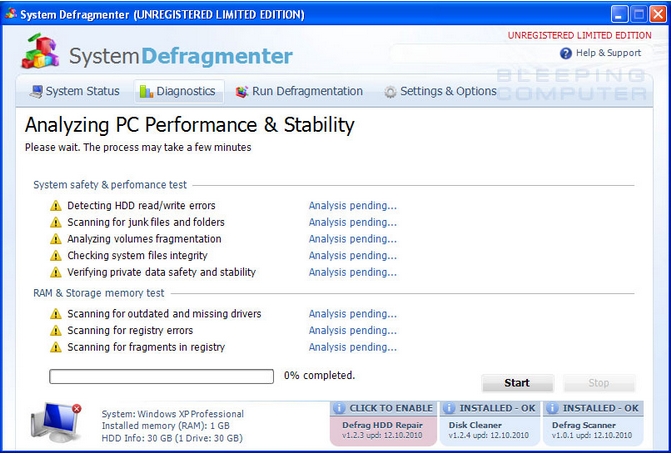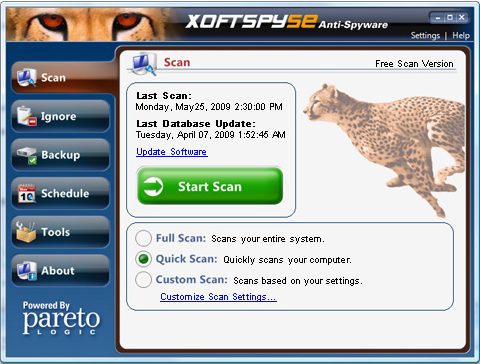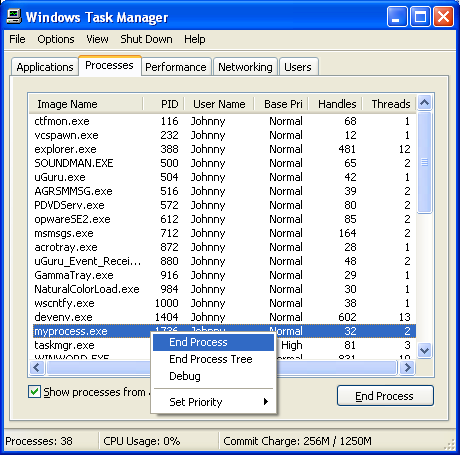System Defragmenter is a rogue program that disguises as another Windows security tool offering Hard Disk Drive Defrag and Repair, Disk Cleaner and Disk Scanner. Computer currently in possession of System Defragmenter is at risks and requires immediate attention.
Normally, a Windows-based computer has a System Defragmenter tool but as usual, some hackers and malware developers are trying to spread a false System Defragmenter virus throughout the web.
The Secure Defragmenter virus is a fake application which has been designed to trick you into buying the false upgrade to the infection, as well as to steal your personal details. The infection will typically install itself from the likes of a rogue download, fake email attachment or infected website. This particular infection will block vital Windows features, as well as continually pop up onto your screen & show you a huge number of fake alerts. The specific name for this virus is “malware” (malicious software) – which basically means it’s a thinly-disguised infection that will attempt to con as many people as possible into buying the upgrade.
How To Remove Secure Defragmenter From Your PC
Step 1: Download & Install XoftSpySE from here.
You need to install it on your PC and then let it scan your system. If you don’t have access to the Internet (because the Secure Defragmenter virus blocked it) then you should download this tool on another PC and then transfer the installation file via CD or USB pen.
Using this tool is very simple. You need to select the type of scan you want to perform and then press “Scan” to get the tool to do the task. This will send XoftSpy through your system and it will identify all the infected files, removing them for you. This automated tool is the best way to remove the infection because it gets 95% of it.
Step 2: Clean Out The Registry.Download This Registry Cleaner Tool.
XoftSpy is very effective at removing the actual infection from your PC, it does not finish the job properly… and ends up leaving a series of settings on your PC. These are kept in the ‘registry’ database and can actually allow the infection back onto your PC. In order to fully protect yourself, it is recommended that you download a registry cleaner and then use it to remove any of the infected ‘Secure Defragmenter’ registry keys that can still cause problems. This tool is automated and is very easy to use.
You should open up the “Task Manager” by clicking CTRL + ALT + DEL and then click on the “Processes” tab. This will then display a list of running processes, where you should then be able to find the listed files above. Click on each one and then click on the “End Process” button to stop the program from running. You can see an example of how that works below:
* %Temp%\exe.exe
* %Temp%\exe.log
* %Temp%\maindll.dll
These directories are where the Secure Defragmenter virus will install itself on your PC. In order to ensure that this virus has been removes from your system in its entirety, you need to remove these directories from your computer. To do this, you need to open up “My Computer” and then locate the directories in question. After you’ve found one, remove it by pressing SHIFT + DELETE on your keyboard (this permanently removes it instead of sending it to your recycle bin).
In order to prevent Secure Defragmenter coming back onto your PC, you need to remove all the registry entries it has entered. This important, because many people leave these intact and end up having the problem come back again. Registry entries store the settings and options for the program, and by using a registry cleaner, you can remove them all and get your computer fit and healthy again. This is highly recommended
Download This Registry Cleaner from here.




![Read more about the article [Tutorial] Guide To Print From iPhone Or iPad Wirelessly](https://thetechjournal.com/wp-content/uploads/2016/05/1-2-512x288.png)
![Read more about the article [Tutorial] How To Identify If Windows Application Is Running In 32 Or 64 Bits](https://thetechjournal.com/wp-content/uploads/2012/03/32-64-bit-logo-512x182.jpg)
![Read more about the article [Tutorial] How To Control Media On Your Laptop or Desktop Computer With Hand Gestures](https://thetechjournal.com/wp-content/uploads/2012/07/hand-guestors-ttj-logo-512x269.jpg)
Thanks for the info! I found this website while DEWORMING my wife’s laptop of this crap. If I could make a suggestion on preventing all future infections and just using your PC in a productive manner:
GET LINUX!
It just works with no B.S.
didnt work
The first program you recommend sucks. Scanned, took almost 45 minutes, then asked me to pay before removing the viruses. If I wanted to pay to fix my comp, wouldn’t I just pay the bloody program the virus is prompting me to buy?! Obviously I’m trying to get around the problem without spending money… recommend Malwarebyte’s anti-malware, then do full scan with any other anti-virus software you may be subscribed to.
This didn’t work – yur product sucks
As the article states, networking is not working so I followed instructions to download the software onto a CD and load it from there. Of course, the first thing the software does is try and update the virus database over the network which fails and causes the program to close. Totally lame.
As the article states, networking is not working so I followed instructions to download the software onto a CD and load it from there. Of course, the first thing the software does is try and update the virus database over the network which fails and causes the program to close. Totally lame.
This is another BS webiste to answer a serious hacker problem- go to hell you guys